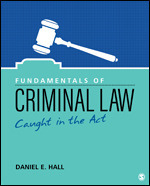You are in: North America
Change location
You are here
Fundamentals of Criminal Law
Experienced Criminal Law Professor Daniel E. Hall shares why he believes in accessible, yet challenging course content.
By Daniel E. Hall author of Fundamentals of Criminal Law: Caught in the Act

The United States is in the midst of significant changes in criminal justice. Calls to reform the police, to reconsider what conduct should be punished, to square contemporary attempts to criminalize threats and intimidation with the First Amendment (which have been exacerbated by digital communication), and calls to account for the Nation’s history of racial and gender discrimination are all challenging historic criminal law norms and assumptions. I have taught criminal law and procedure for thirty years. I have found one of the greatest challenges to teaching criminal law is to teach the law as it is while doing justice to the future.
The Importance of Real-life Illustrations, Excerpted Judicial Cases, and Application of Concepts
The primary objective of my new text, Fundamentals of Criminal Law: Caught in the Act, is to present the state of the law in an accessible, but challenging, manner. Chapter titles, hypotheticals, and real-life illustrations that students could connect to were chosen. The writing style is gauged to be friendly to the undergraduate student without dumbing down the content. Because application is important to learning, chapter questions and problems appear after every module, when the newly learned material is fresh. A feature titled Digging Deeper presents excerpted judicial cases that illustrate the law being studied. I have found that students connect to the reality of caselaw and, of course, reading and thinking through judicial opinions develops student analytical skills.
Contemporary Issues
The elements of crimes, causation, the purposes of criminal law, defenses, and other fundamental principles are fully explored. Moving beyond the state of law, contemporary problems are addressed throughout the book. The nature of culpability—what conduct should be punished and how severely—is presently in the public consciousness. Recent homicides, particularly of racial minorities, by police officers and murders and assaults by individuals who effect “citizen arrests,” or defend themselves or property, have called attention to the appropriate bounds of police use of force and self defense. The fairness of the felony murder rule and other culpability doctrines are being revisited in many jurisdictions. These issues are addressed in several different areas of the book. The moral culpability of those who commit crimes while insane, including the SCOTUS decision regarding the absence of a right to plead insanity, are discussed in the Digging Deeper feature in chapter six.
New Constitutional Questions
Rapidly developing and ubiquitous digital and electronic technology is presenting new problems, resulting in new or adapted statutory law. Many of these laws are giving rise to constitutional questions. New laws criminalizing cyberthreats, for example, are challenging existing First Amendment jurisprudence. The still-in-development True Threats Doctrine is discussed in chapter seven. The related crimes of sexting and revenge porn, two of which are covered in Digging Deeper features, are addressed in chapter 10.
The Line Between Protected and Unprotected Conduct
Crimes against the state have been in full view in recent years, from the events at the Capitol on January 6, 2021, to the street violence that erupted out of protests of police shootings in various shootings in 2020 and 2021. Each of these events involved people engaging in both lawful First Amendment protected expression and assembly and constitutionally unprotected conduct. The specific crimes that were committed and the line between unprotected and protected conduct is discussed in chapter 12.
Racial and Gender Equity
No discussion of contemporary criminal law is complete without examining racial and gender equity. Criminal and civil culpability for civil rights violations is reviewed in chapter seven. Specifically, calls to hold police accountable for use of force, including the impact that qualified immunity has on civil liability, are presented. Cultural norms about rape and sexual assault have changed considerably in recent decades. Consequently, the definitions of these crimes have changed in ways that are intended to better protect the public from these crimes. This evolution is detailed in chapter seven.
Criminal law is an exciting and important subject. It is my hope that Fundamentals of Criminal Law: Caught in the Act proves to be an effective aid to your teaching and to your students' learning.





